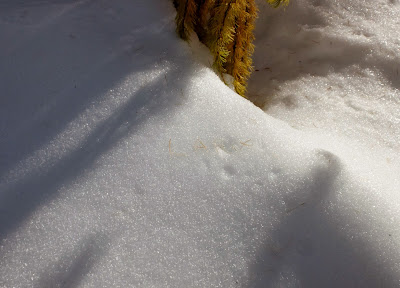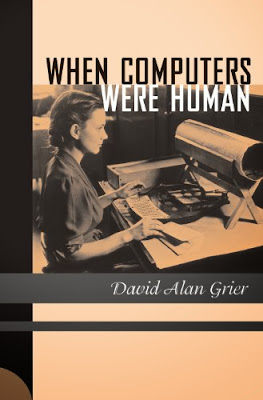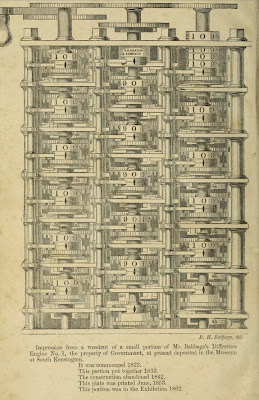

I have no idea what these figures mean or what “Handsom Hank”, above the figures, means or even if I’m reading it right. Oh well, it’s a cool design. The wall is located on the north wall of Urban Crossfit, on Dexter Avenue in Seattle.




Left: Mist Through the Trees; Right: Mist Over Lake Wenatchee
Just over a year ago we were here (Lake Wenatchee Misty Fall Day- Plants We Noticed on a Sunday Morning) at the cabin and it was a misty fall day. Today: blue skies and perfect weather for a little investigation of the flora around the cabin. Most of the trees cabin lot are Ponderosa Pine (Pinus ponderosa) and fir or hemlock (I got stuck on the identification key where it asks “twigs warty where old needles have fallen of”). The understory is composed of Oregon Grape (Mahonia), Oceanspray (Holodiscus discolor), Birchleaf Spiraea (Spiraea betulifolia), Oregon boxleaf (Paxistima myrsinites), Elderberry (Sambucus), Common Snowberry (Symphoricarpos albus), and Western Mountain-Ash (Sorbus scopulina) to name a few.
Left: Nightstand Insect Visitor (Dead); Right: Birchleaf Spiraea
Left: Oceanspray; Right: Birchleaf Spiraea
Left: Larix Spelled in Needles in the Snow; Right: Larch Branch on Carne Mountain
“It’s a matter of elevation” the young man informed us. When trying to decide what kind of larch you are looking at, think about your elevation. According to him, since we were near the top of Carne Mountain, and we were above 6,000 feet, we were looking at subalpine (or just alpine) larch, Larix lyallii. The other type of larch in the Northwest is the western larch, Larix occidentalis.
In this Binomen Art series post, we are spelling out Larix, the scientific name for the larch genus. We spell out the name with the golden needles of larch on snow. Larch are conifers and deciduous. They shed their needles, but before they do, there is site to behold.
The young man –we had about 20 years on him – was carrying a book. Really, he was clutching it, and it being Northwest Trees: Identifying and Understanding the Region’s Native Trees by Stephen Arno and illustrated by Ramona P. Hammerly. The first edition of this book appeared in 1977. When our copy arrived a few days later, we immediately took a liking to it. This beautifully illustrated guide book really captures the “character” of the trees in an engaging way that books full of detailed photographs often miss.
The chapters on western larch and alpine larch sounded strangely familiar as the book-clutcher has recited quite literally from the book as we’ll do:
In the Cascades, alpine larch can be found from central Washington’s Wenatchee Mountains northward about 120 miles (190 km) just into the southern edge of British Columbia. It is found mainly above 6000 feet (1800 m) … [Northwest Trees, p 49]
On the Carne Mountain hike, we hit the larches as we entered the Carne Basin (a cirque I believe) at about 6,100 feet. So by elevation, it was most likely L. lyalli. According to Northwest Trees [p 43], the western larch (L. occidentalis) grows up to about 6,000 feet. Beyond elevation you can also use other simple diagnostics to distinguish between the two species. According to Pacific Coast Tree Finder [pocket manual] and other sources, if the needles are four-sided, it’s an alpine larch. If the needles are three-sided, it’s a western larch. If only we thought to twirl the needles between our fingers. Another way to help distinguish between the two species of larches is to look at the current-year twigs: for alpine larch they are woolly and for western larch they are not.
According to Quattrocchi, the generic name origin is:
From the Latin classical name larix, icis “a larch, larch tree,” used by Plinius and Vitruvius; see P. Sella, Glossario latino italiano. Stato della Chiesa – Veneto – Abruzzi. Città del Vaticano 1944.
As an aside: there really is a Glossario latino italiano. And, if you search inside the book for “larice” (larch in Italian), you see there is an something written. Unfortunately, we can’t see much of it. We’ll trust Quattrocchi on this.
The specific epithet occidentalis means “western”, while lyalli honors the Scot David Lyall (1817–1895).
Left: Trail Through Carne Basin to Carne Mountain and Area of Larch (Google Earth); Right: Larix spelled with Larch Needles in the Snow




Left: Elevation Profile of Carne Mountain Hike; Right: A Hiker Coming Up to the Peak of Carne Mountain
The pyramid profile we captured of our hike up and back from Carne Mountain explains this hike: steep. However, the view of the larches made it all worth while. The last time we saw larches was on a hike near Bolzano in 2007. Those were likely Larix decidua, native to central Europe. On this hike, you really get into the thick of larches when you enter the Carne Basin at around 6,100 feet. The larches that grow here are likely Alpine Larch (Larix lyalli). You will also see a lot of Whitebark Pine (Pinus albicaulis) mixed in as you climb the last ¼ mile to the peak.
On this fall day, the weather was warm and the white snow, blue skies, and yellow needles of the larches made for memorable scenery. For more about the larch, see Binomen Art – Larix (Larch).
Length: 8.3 miles
Duration: < 6 hours; left trailhead at 9:45 am and returned at 3:20 pm.
Elevation: gain 4,400 ft, started at 3,600 ft; Carne peak at 7,050 ft (we recorded), 7,085 ft (reported by WTA site).
Location: Central Cascades -- Stevens Pass - East, Okanogan Wenatchee National Forest.
Notes: 10th hike of the season, total miles including this hike = 115.2 miles.
Larch Photos: Left – A Blur of Larches Approaching the Peak of Carne Mountain; Center: Larix Needles in the Snow; Right: A Larix Branch in Carne Basin
Left: Golden Larch Lights the Way Up To Carne Mountain; Right: The Peak of Carne Mountain
Left: Entering Carne Basin at about 6,100 feet; Center: Snow and Larch in Carne Basin; Right: Stopping for Lunch Near the Peak of Carne Mountain We Hit a Patch of Ladybugs!
Left: At the Peak of Carne Mountain Looking East; Center: View West from Carne Mountain; Left: View North from Carne Mountain
Left: Floor Plan of the Computer History Museum; Right: Difference Engine #2
The Computer History Museum started life in 1979 as the Digital Computer Museum inside of Digital Equipment Corporation’s office in Massachusetts. Today, it is an independent non-profit, located in Mountain View, California. The museum has a large and interesting collection worthy of a few hours of time if you are in the area and you are even mildly interested in computers. Compared to the nearby Intel Museum, I would recommend the Computer History Museum as your first stop, if not only to see the fascinating Babbage Difference Engine #2 in action. Call or write to ask when live demonstrations of the Different Engine #2 occur.
Left: Napier’s Bones, England, ca. 1700; Right: Hollerith Tabulating Machine
Some characters that caught my attention as I made my way through the main exhibition Revolution: The First 2000 Years of Computing.
I’ll mention two themes that recently I’ve been thinking and reading about in the history of computing. The first theme is the idea of simplifying a problem to a form that can be more easily solved. The second theme is how the role of humans has changed in time in the history of computing.
Napier’s Bones exhibit the simplification theme in that they reduce complex multiplication to simpler steps that can be easily understood. The Difference Engine #2 demonstrates the simplification theme a little more abstractly. The engine uses the concept of finite differences to turn the problem of finding values of a polynomial into a one of constructing simple tables based only on addition and subtraction. The prosthaphaeresis algorithm is another, classic example of simplification where multiplication and division are approximated using formulas from trigonometry and look-up tables.
Left: The Philosophical Breakfast Club. Cover shows portraits of Charles Babbage, John Herschel, William Whewell, and Richard Jones.
Right: When Computers Were Human. Cover shows an operator of a Pantograph Card Punch for creating cards that could be read in the Hollerith Tabulating Machine

The second theme of the changing role of humans in the history of computing is covered in the interesting book When Computers Were Human by David Alan Grier. The book “attempts to invert the history of scientific computing by narrating the stories of those who actually did the calculations.” True to the title, many of the stories are of people who were really “human computers”. For example, in the case of the Hollerith tabulating machine, humans collected the information, punched the cards, and then fed the cards to the tabulator. Humans were an integral if not manual part of the computing process.
For the Difference Engine #2, Babbage was inspired to “calculate with steam” as a way to reduce the number of errors in the mathematical tables so critically used in different fields of science. In Babbage’s time, those tables were constructed by “human computers”. The humans crunch numbers that were collected and rolled up into what might be a table of logarithms.
A humorous example of human computers, mentioned in When Computers Were Human and also detailed in the article "Work for the Hairdressers: The Production of de Prony's Logarithmic and Trigonometric Tables" by I. Grattan-Guiness, is how a large set of logarithmic and trigonometric tables were produced at the end of the 18th century under the direction of the French mathematician and engineer, Gaspard Riche de Prony (1755 – 1839). The production of the tables was based on three groups or sections working together. The first group chose the mathematical formulas. The second group set up the calculations based on the formulas and sent them to the third group which performed the bulk of the calculations (simple addition and subtraction):
These calculations were done by the third section [group], a large team of between 60 and 80 assistants. Many of these workers were unemployed hairdressers: one of the most hated symbols of the ancien regime was the hairstyles of the aristocracy, and the obligatory reduction of coiffure “as the geometers say, to its most simplest expression” left the hairdressing trade in a severe state of recession. Thus these artists were converted into elementary arithmeticians, executing only additions and subtractions.”
Another example of human computers that caught my attention is described by Grier in Chapter Two, The Children of Adam Smith. In 1765, the Royal Astronomer Nevil Maskelyne (1732 – 1811) was tasked with producing an almanac. The striking fact about the undertaking (at least to me) is that Maskelyne organized a cottage industry of human computers that received and sent their work through the mail. Grier describes it as follows:
For the Nautical Almanac computers, Maskelyne provided paper, ink, and instructions that were called “computing plans.” Maskelyne wrote these plans on one side of a heavy sheet of folded stationery. The instructions, scrawled in a slightly disheveled hand, summarized each step of the calculation. Occasionally, he would illustrate the computations with a hasty sketch of an astronomical triangle. On the other side of the paper he drew a blank table, ready for the computer to complete. [Grier, David Alan (2013-11-01). When Computers Were Human (p. 30). Princeton University Press. Kindle Edition.]
Maybe all this is a bit of nostalgia on my part. Today’s computing scene is too complex to grasp – at least at time – and it’s easier to take comfort in the past. Maybe I could be one of those human computers working on a logarithm table? Accordingly, it didn’t escape my notice that the bulk of my time at the Computer History Museum was spent with the pre-19th century devices.
Left: Images of a small portion of Difference Image #1 from Passages from the Life of a Philosopher (1864) by Charles Babbage.
Right: Difference Engine #2 in the Computer History Museum, Mountain View, California
Left: IBM Watson versus Travelmarx (losing) on a Jeopardy! Stage Set at the Computer History Museum, Mountain View, California.
Right: EAI 580 Patch Panel - Electronic Associates, Inc. US, ca. 1968.
Another couple days in Mountain View and a few more images that I took back to Seattle.
A milk snail (Otala lactea) crossing the trail that runs a few feet north Amphitheatre Pkwy. On this particular morning, I’m heading east toward Crittenden Lane around 8:15 am on a trusty GBike. I stop to take a picture of a snail, thinking about how I could have run it over. The snail crossing the trail is perhaps a good analogy to what I’m feeling about my job at the moment. I’ve photographed O. lactea on a few previous occasions in and around Vista Slope, the 65-acre park bordered by Permanente Creek on the west, Amphitheatre Pkwy on the south, and Shoreline Amphitheatre on the east.
Left: Otala lactea crossing a trail near Vista Slope; Right: Otala lactea on a Deborah Butterfield Horse
Left: Climbing up to Vista Slope; Center: View of Moffett Field from Vista Slope; Right: View of South Bay from Vista Slope
The bronze Deborah Butterfield Horse is technically in an open space called the Crittenden Site. I always feel compelled to stop and take a photo. A few months ago, when I stopped and explored the horse closely, I found a geocaching.com capsule in it’s jawbone. I wonder who is this Crittenden that lends his or her name to a lane, a park area, and other places and institutions around Mountain View? John J. Crittenden?
Left: Deborah Butterfield Horse in Crittenden Site; Right: Geocaching capsule in the horse
William King’s Vision Sculpture [1987] is a prominent landmark on Charleston Road. The three-story sculpture features a boy leaning out of a window. Or is that a cage that surrounds him? The boy is looking toward Vista Slope. Perhaps looking for a big O. lactea to eat…they are edible.
William King’s Vision Sculpture – Google Campus
Left: A glimmer of the Google logo; Right: Nighttime at Crittenden waiting for a bus with a GBike
Schinus molle – known by many common names like Peruvian peppertree (my favorite) – is a tree I’ve started to notice on on the streets and the wild places along trails and creeks. S. molle is part of the cashew or sumac family (Anacardiaceae). Quattrocchi says of the generic name: “From schinos, the Greek name for the mastic tree, Pistacia lentiscus L., Latin schino or schinus, i, as some species yield mastic-like juices or resin; see Carl Linnaeus, Species Plantarum. 388. 1753 and Genera Plantarum. Ed. 5. 184. 1754.”
Left: Schinus molle flowers; Right: Schinus molle tree on North Shoreline Blvd